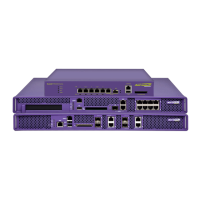Controller Management
Summit WM3000 Series Controller System Reference Guide440
1 Select Management Access > SNMP Trap Receivers from the main menu tree.
2 Refer to the following SNMP trap receiver data to assess whether modifications are required.
3 Highlight an existing Trap Receiver and click the Edit button to display a sub-screen used to modify
the v2c or v3 Trap Receiver.
Edit Trap Receivers as needed if existing trap receiver information is insufficient. You can only
modify the IP address, port and v2c or v3 trap designation within the Edit screen. For more
information, see “Editing SNMP Trap Receivers” on page 441.
4 Highlight an existing Trap Receiver and click the Delete button to remove the Trap Receiver from the
list of available destinations available to receive SNMP trap information.
Remove Trap Receivers as needed if the destination address information is no longer available on the
system.
5 Click the Add button to display a sub-screen used to assign a new Trap Receiver IP Address, Port
Number and v2c or v3 designation to the new trap.
Add trap receivers as needed if the existing trap receiver information is insufficient. For more
information, see “Adding SNMP Trap Receivers” on page 441.
Destination Address
The
Destination Address
defines the numerical (non DNS name)
destination IP address for receiving traps sent by the SNMP agent.
Port
The
Port
specifies a destination User Datagram Protocol (UDP) receiving
traps.
Community String/
User Name
Displays the Community String and User Name specific to the SNMP-
capable client that receives the traps. The community name is public.
Trap Version
The
Trap Version
defines the trap version (v1/2 or v3) defined by the
SNMP-capable client receiving the trap. A trap designation cannot be
modified.

